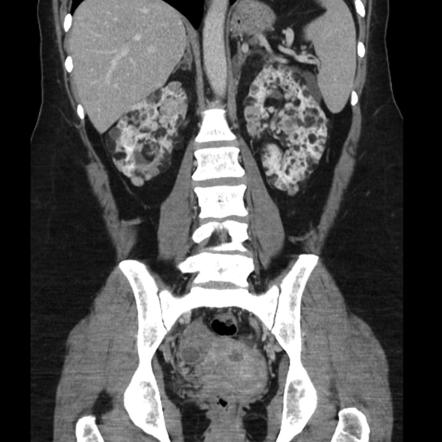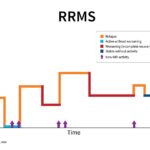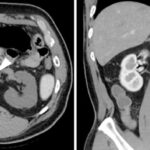Renal angiomyolipoma (AML) is a benign tumor that originates in the kidneys, primarily consisting of fat, muscle, and blood vessels. It is the most common benign renal tumor, and its occurrence can range from asymptomatic lesions to those that cause severe health complications. The relationship between renal angiomyolipomas and tuberous sclerosis complex (TSC) is of particular concern, as TSC significantly increases the likelihood of developing these tumors. This article provides an in-depth understanding of renal angiomyolipoma in the context of tuberous sclerosis complex, including their causes, symptoms, diagnosis, and treatment options.

What is Renal Angiomyolipoma (AML)?
Renal angiomyolipoma is a non-cancerous (benign) tumor composed of three main tissue types: adipose (fat) tissue, smooth muscle, and blood vessels. The tumor typically forms in the kidney, and while it is often asymptomatic, it can lead to significant complications if it grows large or ruptures.
Types of Renal Angiomyolipoma
- Sporadic AML: This type of AML occurs in individuals without any underlying genetic disorders and is often diagnosed incidentally during imaging tests.
- Hereditary AML: When renal angiomyolipomas occur in conjunction with a genetic condition like tuberous sclerosis complex (TSC), they are categorized as hereditary.
Tuberous Sclerosis Complex (TSC) and Its Impact on Renal Health
Tuberous sclerosis complex (TSC) is a rare genetic disorder characterized by the growth of non-cancerous tumors in various organs, including the brain, heart, skin, and kidneys. It is caused by mutations in either the TSC1 or TSC2 genes, which regulate cell growth and division. These mutations result in the uncontrolled proliferation of cells, leading to tumor formation.
TSC is closely associated with the development of renal angiomyolipomas, particularly in individuals with the condition. In fact, around 50-80% of people with TSC will develop renal angiomyolipomas, and in these cases, the tumors tend to be multiple, bilateral (affecting both kidneys), and often grow larger over time.
Key Features of Tuberous Sclerosis Complex:
- Genetic Mutation: TSC is caused by mutations in the TSC1 or TSC2 genes, leading to the formation of benign tumors in multiple organs.
- Renal Involvement: TSC often results in multiple renal angiomyolipomas, which can vary in size and cause complications such as kidney damage, bleeding, and hypertension.
- Other Symptoms: TSC may also cause intellectual disability, seizures, skin lesions, and cardiac problems.
Symptoms and Complications of Renal Angiomyolipoma in Tuberous Sclerosis Complex
Renal angiomyolipomas are often asymptomatic, particularly when they are small. However, in individuals with TSC, the presence of multiple or larger AMLs can lead to various health problems.
Common Symptoms:
- Pain: Large AMLs may cause flank or abdominal pain due to their size or rupture.
- Hematuria: Blood in the urine (hematuria) may occur if the tumor ruptures or bleeds.
- Hypertension: High blood pressure is common, especially when the tumor causes damage to kidney tissue or blood vessels.
- Kidney Dysfunction: In severe cases, AMLs can lead to renal failure, particularly if there are multiple tumors affecting both kidneys.
Complications:
- Tumor Rupture: One of the most dangerous complications of renal AMLs is rupture. When an AML ruptures, it can lead to significant internal bleeding, requiring immediate medical attention.
- Kidney Damage: The growth of AMLs can compromise kidney function over time, particularly if there are numerous tumors in both kidneys.
- Hypertension: Elevated blood pressure is a common result of kidney damage caused by AMLs and can worsen as the tumors grow larger.
Diagnosis of Renal Angiomyolipoma in Tuberous Sclerosis Complex
Diagnosing renal angiomyolipomas in patients with tuberous sclerosis complex requires a combination of clinical evaluation and imaging studies. The diagnosis is often made incidentally, as many individuals with TSC undergo regular screenings for other manifestations of the disease.
Key Diagnostic Methods:
- Ultrasound: A non-invasive and commonly used imaging technique that can identify the presence of renal angiomyolipomas, especially in patients with TSC.
- CT Scan: A more detailed imaging tool that provides better visualization of the size, location, and extent of the tumors. It is particularly useful in identifying larger AMLs or those with complications.
- MRI: Magnetic resonance imaging is another advanced imaging method used to assess renal tumors, providing clear images of soft tissues, including kidney structures.
- Angiography: In rare cases, angiography may be used to assess the blood supply to renal tumors and evaluate for bleeding or other vascular complications.
Treatment Options for Renal Angiomyolipoma with Tuberous Sclerosis Complex
The management of renal angiomyolipomas in the context of tuberous sclerosis complex aims to control symptoms, prevent complications, and preserve kidney function. The choice of treatment depends on the size, number, and symptoms of the tumors.
1. Monitoring and Observation
In many cases, small, asymptomatic renal angiomyolipomas do not require immediate treatment. Regular monitoring with imaging studies (e.g., ultrasound, CT scan) is often recommended to track the growth of the tumors and assess for any potential complications.
2. Medical Management
- Blood Pressure Control: Managing hypertension is crucial in preventing further kidney damage in patients with renal AMLs. Medications like ACE inhibitors or angiotensin receptor blockers (ARBs) may be prescribed to control blood pressure.
- Anticonvulsants: For patients with TSC who experience seizures, anticonvulsant medications may be used to control seizure activity, improving overall quality of life.
- Everolimus: Everolimus, an mTOR inhibitor, has been shown to reduce the size of renal angiomyolipomas in TSC patients and may be used as a treatment option to prevent tumor growth.
3. Surgical Intervention
In cases where renal angiomyolipomas cause significant symptoms or complications (such as rupture or kidney failure), surgery may be necessary. Surgical options include:
- Partial Nephrectomy: The removal of the tumor and a portion of the affected kidney.
- Embolization: A minimally invasive procedure where blood vessels supplying the tumor are blocked to reduce blood flow and prevent rupture.
- Nephrectomy: In rare cases, the entire kidney may need to be removed if the tumor causes irreversible damage.
4. Genetic Counseling and Family Support
As TSC is a genetic condition, genetic counseling is important for families affected by the disease. It can provide valuable information on the inheritance pattern, potential risks for other family members, and options for prenatal testing.
Prognosis and Long-Term Outlook
The prognosis for individuals with renal angiomyolipomas and tuberous sclerosis complex largely depends on the size and number of the tumors, the presence of complications, and the effectiveness of treatment. With appropriate management, most individuals with TSC and renal AMLs can maintain kidney function and live relatively healthy lives.
However, regular follow-up and imaging are essential to monitor tumor growth and detect complications early. In some cases, renal failure or other severe complications may occur, requiring more aggressive interventions.

